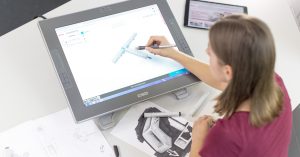
How to efficiently harness and correctly communicate the advantages of digitalisation.
In light of growing customer demands, throughput times in today’s mechanical engineering sector are becoming ever shorter, which piles the pressure onto companies and their employees. That’s why it’s crucial that companies are quick to grab new opportunities to optimise processes for the future of mechanical engineering design. In the following interview, expert Florian Palatini, head of sales at item, explains how digital engineering intelligently expands and seamlessly combines long-established digital elements of mechanical engineering. He shows how it is often relatively small interventions that – when put to good use – give companies a distinct edge on the competition.
What is digital engineering and how does it affect me as a mechanical engineer?
After years of grappling with the theory and concepts behind Industry 4.0, companies are now incorporating more and more aspects into their actual business operations and their employees’ day-to-day work. It’s not about digitalising an entire factory in one go, but rather transitioning to the digital era one area at a time. Prime examples include supervisors monitoring machine data via an iPad, machines automatically ordering goods and the increased use of intelligent automated guided vehicle systems.
The gradual digitalisation of German industry is giving rise to a number of challenges, particularly in the mechanical engineering sector. Companies need to ascertain what effects the digital revolution will have on their traditional fields of business and how they can translate these effects into future business models. Digital engineering is an area that could help the mechanical engineering sector benefit from digitalisation both in terms of in-house processes and the interface with the customer.
But isn’t the mechanical engineering sector digital already? After all, 3D data and CAD are already indispensable.
Thanks to engineers’ innovative prowess, the mechanical engineering sector has always picked up on trends or even set them. But digital engineering is much more than just using CAD and 3D data as a sort of island solution. It opens up opportunities to network engineers and their projects – far beyond what currently passes for project engineering.
Digital engineering opens up opportunities far beyond what currently passes for project engineering.
This concerns, for instance, the extent to which digitalisation can help integrate upstream and downstream tasks and processes such as production and after-sales service into an engineer’s workflow. The opportunities in this regard include interdepartmental collaboration and optimisation with the help of entirely digital processes.
Is the potential increase in process efficiency really worth the necessary investment in infrastructure?
The term “Industry 4.0” sometimes scares people off, as they often don’t fully grasp what it means in practical terms for their business. Every mechanical engineering company will reach a different conclusion as to which strategy and measures are appropriate and cost-effective for them.
You don’t always have to devise a master plan to make significant improvements and achieve greater efficiency. Just choosing the right partner and integrating small, appropriate tools often helps to efficiently derive practical advantages from digitalisation. And given the shortage of skilled workers in Germany, you simply can’t put a price on the added value gained by implementing carefully thought-through interdepartmental processes.

What else in particular should mechanical engineers watch out for in relation to those points?
Using the current options available through digitalisation to combine and adapt individual processes is no sure-fire success. Companies need to make a conscious strategic decision before they can start to enjoy the benefits we’ve discussed. This is where employees undoubtedly play a key role – they need to be brought on board and kept on board because their working processes will change. Senior managers need to monitor these changes and developments to assess the associated opportunities and risks.
At its core, digital engineering is about efficiently interlinking standard processes.
The opportunities in particular need to be made very clear to employees. At the heart of it all, digital engineering is about efficiently interlinking standard processes. The time saved allows employees to focus on value-adding tasks, such as the actual design and engineering work. If companies manage to clearly communicate such advantages, employees will automatically be more open to changes affecting established processes.
What is the best way to communicate digital engineering within a company?
From an employee’s perspective, efficiently linking standard processes ultimately means no longer having to carry out unnecessary repetitive tasks. The item Engineeringtool, for example, offers smart functions for automating numerous steps in 3D engineering. Another important aspect is the digital transfer of data within the process chain, which eliminates the cumbersome task of re-entering data by hand, such as when ordering components for a construction.
What’s more, automatically transferring data removes the risk of employees re-entering it incorrectly. Despite clear-cut benefits for the workforce, it is important to talk about the benefits that digital engineering offers the company, too. Ultimately, that means being transparent when it comes to communicating the importance of a digitalisation strategy for the future of the company – and therefore for the safety of employees’ jobs.
How exactly will digital engineering improve mechanical engineering processes in the future?
The mechanical engineering sector of the future will not be based solely around the classic concept of selling machinery, but will generate more sales from services related to machinery, such as predictive maintenance and plant optimization. Having constant access to a backed-up online archive containing the entire project history and real-time coordination with customers on site offer added value in this regard to further develop the business model. Digitalisation can also make it considerably easier for several engineers to collaborate on the same projects and share project information with the customer easily online without the need for special CAD readers.
Will this give rise to new business models, too?
Our goal is to actively shape the future of mechanical engineering by utilising more than 40 years of innovation experience.
If you take a look around at the leading trade fair in Hanover, you will notice that more and more machine manufacturers are turning into software developers. The companies that manage to win over customers with a combination of hardware and software or even tap into new fields of business will take the lead in the era of digitalisation. The high-performance item Engineeringtool already enables our customers to turn the advantages of digital engineering into an edge over their competitors. Our goal is to actively shape the future of mechanical engineering by utilising our more than 40 years of experience in developing innovations.





